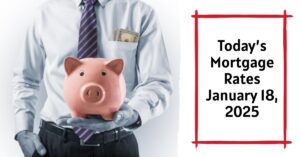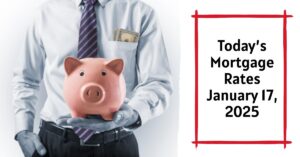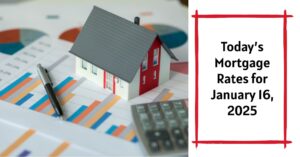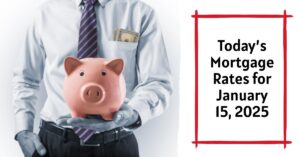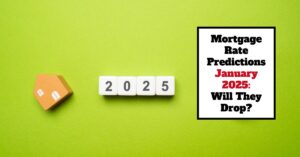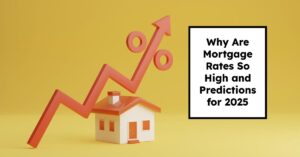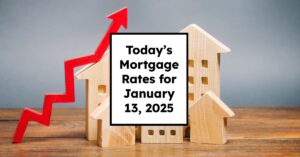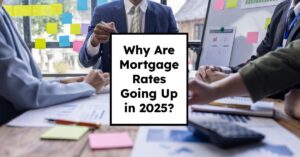As of January 18, 2025, today's mortgage rates for the benchmark 30-year fixed mortgage average around 7.11%, experiencing a slight rise from the previous week. Understanding these rates is crucial for homebuyers and those looking to refinance, as they can significantly influence monthly mortgage payments and overall loan costs. With changing financial dynamics, being well-informed can help you make better financial decisions regarding your home purchase or refinancing options.
Today’s Mortgage Rates Rise: January 18, 2025 Trends & Insights
Key Takeaways
- Current Average Rate: 7.11% for a 30-year fixed mortgage.
- Refinance Rate: 7.09% for a 30-year fixed refinance.
- 15-Year Fixed Rate: 6.42%, slightly higher than last week.
- Savings by Comparison: Top offers can be up to 0.58% lower than the national average.
- Future Predictions: Experts anticipate a slight decrease in mortgage rates in 2024.
In today's financial climate, it’s essential to keep a close eye on mortgage rates, as they directly impact how much you pay for your home over time. Whether you're purchasing or refinancing a home, knowing these values can save you a significant amount of money.
Understanding Today's Mortgage Rates
The mortgage landscape as of January 18, 2025, shows that the average interest rate for a 30-year fixed mortgage has increased slightly by 8 basis points. This small uptick is reflective of broader economic trends, including recent inflation numbers and the ongoing policies from the Federal Reserve. Notably, the average 30-year fixed mortgage stands at 7.11%, while the average refinance interest rate is 7.09%.
Here’s a breakdown of the mortgage rates for different terms as of today:
| Loan Type | Interest Rate | APR |
|---|---|---|
| 30-Year Fixed Rate | 7.11% | 7.16% |
| 20-Year Fixed Rate | 6.91% | 6.97% |
| 15-Year Fixed Rate | 6.39% | 6.47% |
| 10-Year Fixed Rate | 6.30% | 6.38% |
| 5-1 ARM | 6.56% | 7.11% |
| 10-1 ARM | 6.84% | 6.95% |
| 30-Year Fixed FHA | 7.07% | 7.12% |
| 30-Year Fixed VA | 6.88% | 6.92% |
| 30-Year Fixed Jumbo | 7.14% | 7.19% |
Data as of January 18, 2025, sourced from Bankrate.
Why Mortgage Rates Matter
Mortgage rates are more than just numbers; they represent a fundamental aspect of your financial future. They influence how much homebuyers can afford, dictate the pace of the housing market, and directly affect the economy's overall health. When mortgage rates are low, it becomes more enticing for buyers to enter the market. Conversely, when rates rise, potential buyers may hesitate, causing a downturn in housing market activity, which may have a ripple effect on the economy.
In recent weeks, rates have shown an upward trend, correlating with economic indicators, including inflation statistics released by the U.S. Department of Labor. For example, inflation edged up to 2.9% in December, which can prompt the Federal Reserve to adjust its monetary policies, ultimately affecting mortgage rates.
The fluctuations in mortgage rates can have a broad impact. For instance, a slight increase can amount to hundreds of dollars more in payments each year for homeowners—an important consideration for many budgeting families.
The Federal Reserve and Its Impact on Mortgage Rates
While the Federal Reserve does not set mortgage rates directly, its policies significantly influence them. The Fed's decisions about the federal funds rate impact how lenders set their own rates. Last month, the Federal Reserve cut its benchmark interest rate for the third time in a row, yet mortgage rates have been on the rise. This contradictory dynamic highlights that mortgage rates follow market yields, particularly those on 10-year Treasury bonds, rather than the federal funds rate itself.
Real estate professionals, including Ken H. Johnson, have noted that the anticipated decline in mortgage rates did not happen as predicted, and rates now hover above 7% instead of moving back to sub-6% territory. The disconnect between the Fed's actions and mortgage rates underscores the complexities of the financial markets.
Interest Rate Expectations Moving Forward
Experts are cautiously optimistic about the potential for a decline in mortgage rates in 2024. Recent reports suggest that inflation is beginning to moderate, creating a more favorable environment for lower mortgage rates. If inflation continues to cool, it could lead to a more stable interest rate environment, providing buyers with better financing options down the line.
Comparing Mortgage Rates: A Smart Move
As the market changes, comparing mortgage rates becomes increasingly crucial. Current trends show that potential homebuyers could save up to $1,200 a year by shopping around for rates, demonstrating the tangible benefits of comparison. The difference between lenders can range significantly, especially when examining both interest rates and the APR, which measures the complete cost of borrowing.
Additionally, obtaining multiple quotes allows borrowers to leverage competitive offers to their advantage. When considering a mortgage, it’s essential to evaluate not just the interest rate but also the fees associated with the loan, as these can vary significantly between lenders.
The Importance of Timing in the Mortgage Process
Timing can play a vital role in securing the best mortgage rates. Those who act during periods of falling rates can greatly benefit, but buyers need to be ready and informed to act quickly. Since rates fluctuate frequently, having a plan and knowledge about the current market can help individuals capitalize on favorable conditions.
Recommended Read:
Mortgage Rates for January 17, 2025: Trends and Data
Mortgage Rates Rise Past 7% in January: Highest in 7 Months
Mortgage Rates Rise to the Highest Level Since July Last Year
Current Market Dynamics and Consumer Behaviour
Despite the recent hike in mortgage rates, some experts anticipate that rates will ease in the coming weeks. Financial markets reacted positively to December's wholesale inflation report, suggesting the potential for more favorable rates in the near future. Melissa Cohn, a Regional Vice President at William Raveis Mortgage, reported optimism regarding lower rates in the upcoming week, reflecting confidence that inflation rates may stabilize.
Consumers' behaviors are also shifting with the changing economic climate. The rising rates have prompted many potential buyers to reconsider their plans. For instance, first-time homebuyers might feel discouraged by achieving their homeownership goals at higher rates, while seasoned buyers may look to leverage current equity to refinance and save on costs.
Factors Influencing Your Mortgage Rate
When determining your mortgage rate, multiple factors come into play. Here are some of the most significant:
- Credit Score: Borrowers with higher credit scores typically receive better interest rates. A strong credit profile signals to lenders that you are a lower-risk borrower, potentially saving you thousands over the life of your loan.
- Down Payment Size: A larger down payment often leads to lower rates. Many lenders reward borrowers who are able to put more money down at closing, viewing them as less of a risk.
- Loan Amount: The size of the loan can impact the rate offered. Larger loans may have different scaling compared to smaller amounts.
- Loan Type: Fixed vs. adjustable-rate loans can yield different rates, as ARMs might start with lower rates but can change significantly after an introductory period.
- Location: Local market conditions and regional economic factors may affect rates.
- Economic Trends: Factors like inflation, Federal Reserve actions, and investor demand play critical roles.
- Housing Market Conditions: In highly competitive housing markets, rates may rise due to increased demand and lower inventory of homes.
With these factors in mind, anyone involved in the mortgage market must remain vigilant and informed about how fluctuations can affect their financial future.
Key Terms to Know
Understanding key terms can help consumers navigate the mortgage landscape more confidently:
- APR (Annual Percentage Rate): This includes the interest rate plus any additional fees and costs, providing a more comprehensive picture of your mortgage costs.
- Discount Points: Paying upfront to lower your interest rate can be beneficial over the duration of your loan, particularly if you plan to stay in your home for a longer period. A single point usually costs 1% of the loan amount and can reduce your rate significantly.
- Fixed-Rate vs. Adjustable-Rate Mortgages (ARMs): Fixed-rate mortgages offer stability with constant rates, while ARMs can fluctuate with the market, potentially offering lower rates initially but carrying risks for future increases.
Regional Differences in Mortgage Rates
Mortgage rates can vary significantly across states and regions due to local economic conditions and competition among lenders. It’s essential to research and understand how rates in your area compare to national averages. Some regions may showcase distinct markups or reductions based on their economic environments.
| State | Average Mortgage Rate |
|---|---|
| New York | 7.15% |
| California | 7.16% |
| Texas | 7.05% |
| Florida | 7.14% |
| Illinois | 7.12% |
Data based on current trends and regional reports.
Understanding these variances can help buyers and those looking to refinance make more informed choices about where to secure their loans and under what terms.
The Importance of Expert Opinions
While analyzing mortgage rates, it's beneficial to consider expert insights from industry professionals. Market analysts, economists, and financial advisors can provide valuable perspectives that aren't just based on current rates but also on predictive trends. Engaging with these experts can help you grasp the potential future changes in the housing market, providing a clearer picture of what you can expect as you navigate your home financing options.
Work with Norada in 2025, Your Trusted Source for
Real Estate Investing
With mortgage rates fluctuating, investing in turnkey real estate
can help you secure consistent returns.
Expand your portfolio confidently, even in a shifting interest rate environment.
Speak with our expert investment counselors (No Obligation):
(800) 611-3060
Recommended Read:
- 30-Year Mortgage Rate Forecast for the Next 5 Years
- 15-Year Mortgage Rate Forecast for the Next 5 Years
- Why Are Mortgage Rates Going Up in 2025: Will Rates Drop?
- Why Are Mortgage Rates So High and Predictions for 2025
- NAR Predicts 6% Mortgage Rates in 2025 Will Boost Housing Market
- Mortgage Rates Predictions for 2025: Expert Forecast
- Will Mortgage Rates Ever Be 3% Again: Future Outlook
- Mortgage Rates Predictions for Next 2 Years
- Mortgage Rate Predictions for Next 5 Years
- Mortgage Rate Predictions for 2025: Expert Forecast
- Mortgage Rate Predictions: Why 2% and 3% Rates are Out of Reach
- How Lower Mortgage Rates Can Save You Thousands?
- How to Get a Low Mortgage Interest Rate?
- Will Mortgage Rates Ever Be 4% Again?
